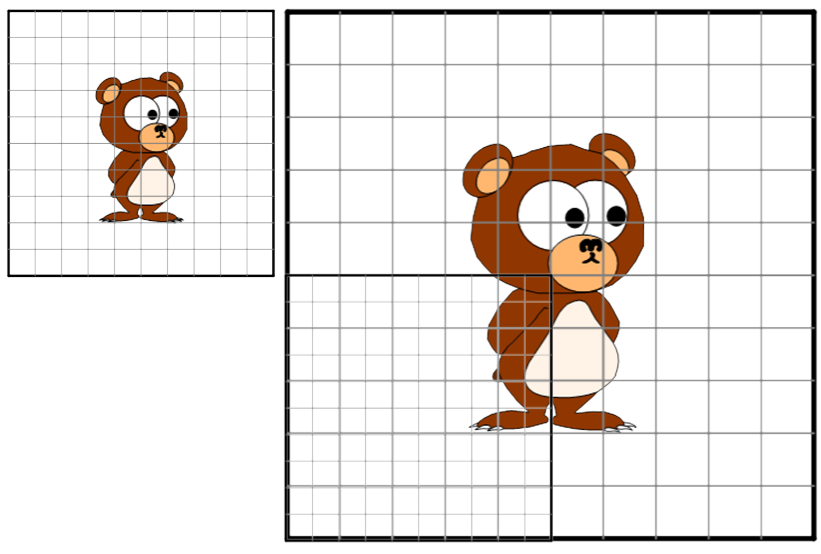
If you have a 2-D shape, you can imagine what it would look like if you stretch (or shrink) it in just one direction:

The stretched out hearts are both bigger. How much bigger?
![]() 1. Copy this table, and then fill it out by using an online tool or (if that doesn't work) watching this video.
1. Copy this table, and then fill it out by using an online tool or (if that doesn't work) watching this video.
| Original area (A) | horizontal scale factor (h) | vertical scale factor (v) | new area (N) | area ratio/change factor (c)* |
| 2 | 1 | |||
| 3 | 1 | |||
| 1 | 2 | |||
| 3 | 2 | |||
| 2 | 2 | |||
| 1/2 | 1 | |||
| 1/2 | 1/2 |
*The area ratio or change factor is the number you multiply the original area by to find the new area. You can find the area ratio or area change factor by dividing: (new area)/(original area)
![]() 2. Write a formula to summarize what you found: If A is the original area, and it is scaled by a horizontal scale factor of h and a vertical scale factor of v then the new area will be: N=_________________
2. Write a formula to summarize what you found: If A is the original area, and it is scaled by a horizontal scale factor of h and a vertical scale factor of v then the new area will be: N=_________________
If you have a similar figure, then the scale factor is the same both horizontally and vertically. If you stretch by 2x horizontally, you're also stretching by 2x vertically, so the area gets doubled twice:
When I make a similar figure to this bear by making it twice as wide and twice as high, then each of the squares is 4 times as big as a small square. That makes the area of the large bear 4 times the area of the small bear.

![]() 3. Copy this table, and fill it out using this online tool or by watching this video.
3. Copy this table, and fill it out using this online tool or by watching this video.
This tool makes similar figures of different sizes.
| Original Area (A) | Scale factor (length in both dimensions) (f) | New area (N) | Area ratio/change factor* (c) |
| 5 cm2 | 2 | ||
| 5 cm2 | 3 | ||
| 5 cm2 | 1/2 | ||
| 8 cm2 | 1/2 | ||
| 6 cm2 | 2 | ||
| 3 cm2 | 4 |
*The area ratio or change factor is the number you multiply the original area by to find the new area. You can find the area ratio or area change factor by dividing: (new area)/(original area)
![]() 4. Write a formula to summarize what you found: If A is the original area, and it is scaled by a length scale factor of f to make a similar shape then the new area will be: N = ________________ and the area ratio (area change factor) will be c = __________
4. Write a formula to summarize what you found: If A is the original area, and it is scaled by a length scale factor of f to make a similar shape then the new area will be: N = ________________ and the area ratio (area change factor) will be c = __________
![]() 5. Use what you figured out to solve these 3 problems:
5. Use what you figured out to solve these 3 problems:
a. I have two pictures of a star. The smaller star has an area of 5 cm2. If the larger star is 3 times as wide and 4 times as high as the smaller star, what is its area? (Note: because the larger star is scaled a different amount horizontally and vertically, it isn't similar and proportional to the smaller star)
b.I have two similar (proportional) pictures of a moon . The larger picture was enlarged to 200% on a standard copy machine from the smaller one (scale factor of 2). If the area of the smaller moon is 9 cm2, what is the area of the larger moon?
c. I have two similar/proportional pictures of a cake. The smaller cake has area 8 cm2, and the area of the large cake is 72cm2. What is the area ratio between the two pictures (comparing large to small)? What is the what (length) scale factor that compares the large one to the small one?
You can watch a video of me showing how to solve some similar problems.